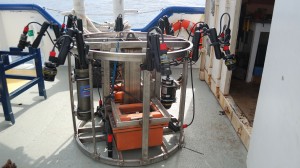OXFORD, Miss. – A new technological marvel that University of Mississippi researchers helped develop – a device called the “I-Spider” – allowed researchers to find a $500,000 unmanned vessel that went missing 4,000 feet below the Gulf of Mexico’s surface.
UM staff members were able to haul the underwater research vehicle, dubbed the Mola Mola, back to the surface. The loss of the Mola Mola would have dealt a serious blow to efforts to understand the lingering effects of the 2010 Gulf oil spill, said Geoff Wheat, a consultant for the National Institute for Undersea Science and Technology, known as NIUST.
“Losing it would have been catastrophic to the scientists working in the Gulf,” Wheat said.
NIUST, which has been based at UM since its establishment in 2002, is a joint effort between Ole Miss and the University of Southern Mississippi in partnership with the National Oceanic and Atmospheric Administration.
The Mola Mola was central to NIUST scientists’ study of the 2010 Deepwater Horizon Oil Spill and to the Ecosystems Impacts of Oil and Gas Inputs to the Gulf, or ECOGIG, project, a UM-led research consortium funded by a $20 million grant through the Gulf of Mexico Research Initiative.
The automated vehicle, which is named for the ocean sunfish, went missing at the beginning of September while being used to make a photo mosaic of the sea floor. The Mola Mola’s systems stopped communicating, and it flooded and sank about 160 miles south of New Orleans. The cause of the malfunction is still unknown.
Efforts quickly began to figure out how to retrieve the Mola Mola. UM research systems specialist Matt Lowe and his team at the Mississippi Mineral Resources Institute assembled the I-Spider, drove it to Cocodrie, La., and loaded it on a ship headed to the site.
Lowe, Steven Tidwell and Marco D’Emidio of UM, as well as Vernon Asper, who leads the NIUST collaborative group at USM, and Max Woolsey and Roy Jarnagin, also from USM, made up the researchers and technical staff onboard the ship.
Equipped with lights, cameras and other electronic equipment, the I-Spider was developed jointly by UM and USM to allow researchers to deposit instruments on the seafloor with pinpoint precision and monitor the seafloor environment. The research team was inspired to develop the device in hopes that it would be more exact and reliable than the acoustic release devices traditionally used to deposit instruments on the seafloor.
The I-Spider’s mission proved successful. The Mola Mola was found and hauled to the surface on the researchers’ third attempt.
“We’ve done something that few people have ever done,” Lowe said. “This is not just everyday operations. Rescuing a vehicle like that takes a lot of hands-on experience with ROVs and some careful planning. It’s not something you just rush into. It’s a testament to how well all the groups work together to make something like this happen. If we can function this well in an emergency situation, we can function even better when the pressure isn’t on.”
